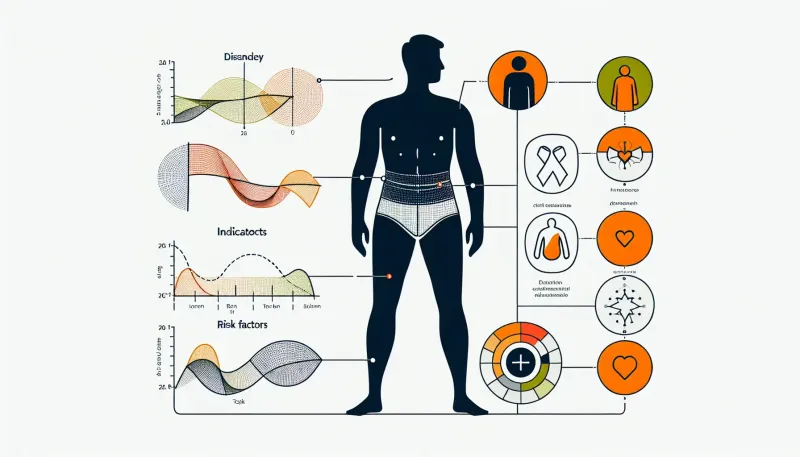Understanding Waist Circumference and Risk Factors: A Comprehensive Guide

Learn about waist circumference and risk factors in this comprehensive guide. Discover how waist size impacts health and what you can do to mitigate risks.
Understanding the significance of waist circumference and its relationship to risk factors can provide valuable insights into overall health and wellness. This comprehensive guide aims to present the key aspects of waist circumference, its implications on health, and ways to manage risk factors effectively.
What is Waist Circumference?
Waist circumference is a simple measurement taken around the narrowest part of the waist, usually just above the belly button. It is a quick and non-invasive method to estimate the amount of abdominal fat a person has. This measurement is crucial as it signifies more than just body weight; it helps determine health risks associated with obesity and other conditions.
How to Measure Waist Circumference Correctly
- Stand up straight and exhale normally.
- Place a measuring tape around your bare stomach, just above your hip bone.
- Ensure the tape is snug but not compressing the skin.
- Take the measurement at the end of a normal expiration.
Waist Circumference and Health Risks
A higher waist circumference can be indicative of a higher risk for various health conditions. This section delves into the specific risks associated with increased waist measurements.
Cardiovascular Diseases
Research indicates a strong link between larger waist circumference and a higher risk of cardiovascular diseases. Abdominal fat is particularly harmful as it surrounds vital organs, potentially leading to conditions like hypertension, high cholesterol, and heart disease.
Type 2 Diabetes
Larger waist circumference is a significant risk factor for type 2 diabetes. Excessive abdominal fat can affect insulin sensitivity, leading to insulin resistance and eventually diabetes. Monitoring and managing waist size is crucial for diabetes prevention.
Metabolic Syndrome
Metabolic syndrome is a cluster of conditions—high blood pressure, high blood sugar, excess body fat around the waist, and abnormal cholesterol levels—that occur together, increasing the risk of heart disease, stroke, and diabetes. Waist circumference is a key indicator used in diagnosing metabolic syndrome.
Other Health Conditions
Excess abdominal fat is also associated with other health risks, such as sleep apnea, certain cancers, and liver disease. Understanding these risks emphasizes the importance of maintaining a healthy waist size.
Factors Influencing Waist Circumference
Several factors contribute to waist circumference, and recognizing these can aid in better management and prevention strategies.
Genetics
Genetics play a substantial role in determining body shape and fat distribution. Individuals with a family history of obesity or related conditions may have a predisposition to larger waist circumference.
Diet and Nutrition
Diet is a critical factor affecting abdominal fat. High-calorie diets rich in sugars and unhealthy fats can contribute significantly to waist size. Conversely, a balanced diet with adequate portions of lean proteins, whole grains, fruits, and vegetables can help manage waist circumference.
Physical Activity
Regular physical activity is vital in managing waist size and overall body fat. Aerobic exercises, strength training, and specific abdominal exercises can help reduce abdominal fat and improve overall fitness.
Stress and Sleep
Chronic stress and poor sleep habits can also influence waist circumference. High stress levels can lead to hormonal imbalances, particularly increased cortisol, which promotes fat storage around the abdomen. Similarly, inadequate sleep is linked to weight gain and larger waist sizes.
Strategies to Manage Waist Circumference and Reduce Risks
There are various effective strategies to help manage waist circumference and lower associated health risks. Implementing these measures can promote better health and well-being.
Healthy Eating Patterns
Adopting a balanced diet, such as the Mediterranean or DASH diet, can play a significant role in controlling waist size. These diets emphasize the intake of vegetables, fruits, whole grains, lean proteins, and healthy fats.
Regular Physical Activity
Engaging in at least 150 minutes of moderate-intensity or 75 minutes of high-intensity physical activity each week can help manage body fat. Incorporating both aerobic exercises and strength training provides the best results.
Stress Management
Effective stress management techniques, such as mindfulness meditation, yoga, and deep-breathing exercises, can help reduce cortisol levels and limit abdominal fat gain.
Improving Sleep Quality
Ensuring sufficient and quality sleep is an essential aspect of weight management. Aim for 7-9 hours of sleep per night, and adopt proper sleep hygiene practices such as maintaining a consistent sleep schedule and creating a restful sleep environment.
Regular Health Check-Ups
Periodic health check-ups and monitoring of waist circumference can help detect early signs of health issues and ensure timely intervention. Consult healthcare professionals for personalized advice and management plans.
Conclusion
Understanding the importance of waist circumference and its associated risk factors is crucial for maintaining optimal health. By recognizing the implications of a larger waist size and implementing effective management strategies, individuals can reduce their risk of various health conditions, promoting longevity and well-being. Regular monitoring, a balanced diet, physical activity, stress management, and adequate sleep form the cornerstone of a healthy lifestyle conducive to maintaining a healthy waist circumference.



























